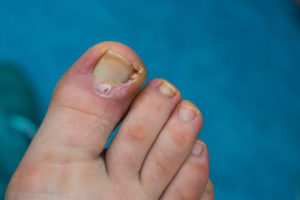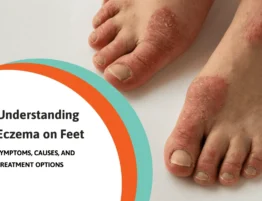

Ingrown nails are one of the most common problems that podiatrists treat. Oftentimes not only is the nail hurting, but there can be a toenail staph infection accompanying the problem. This problem can occur for anyone, but there can be additional risk when there is lack of blood flow to the foot, especially if the patient is diabetic. The staph infection can spread to the soft tissue around the nail, and in rare cases may spread to the bone adjacent to the nail. If the bone gets infected, the patient may need weeks of intravenous antibiotics. Now that we have your attention, let’s discuss what you need to know if you think your nail is ingrown!
Presentation – Signs and Symptoms
With an ingrown toenail, the location is most common in the big toenail. It is typical to experience pain when there is any pressure applied along the side of the nail. There may also be redness and swelling including pus in the area where the pain is. When wearing snug or tight fitted shoes, it is again common to experience pain, especially when compared to walking barefoot.
The Basics
It’s important to note that the most common bacteria on the skin is staph, so if there is a break in the skin, then this is the most common bacteria to cause infection. When an infection is present, it can be resistant to a specific antibiotic. Methicillin resistant staphylococcus aureus could be the cause of the infection, and it’s important to know when antibiotic treatment is done.
Causes of Toenail Staph Infection
- Congenitally Ingrown Nails: The shape of the nail that can lead to an ingrown nail often is inherited. A nail that tends to curve down on the side into the skin may occur more in certain families. We’ll often hear patients say, “yes my father also had ingrown nail issues!”. Unfortunately, there may be little you can do when faced with such a situation.
- Improper Fitting Shoes: Make sure that you size your shoes correctly. This is most important for shoe gear used with more rigorous activity such as running, hiking, skiing or skating.
- Improper Trimming of Nails: It’s often been said to trim your toenails straight across and to a degree this is true. However, if you find that the end of the edge of the nail curves slightly and it’s painful, rounding the corner of the nail can work just fine. Try to avoid “bathroom surgery” as digging further back along the side of the nail usually isn’t going to work.
- Fungal Nails: Onychomycotic nails frequently become ingrown because the fungal infection deforms the nail. Onychomycosis may also cause athlete’s foot in these patients. The nail may become thicker and cause pressure on the sides of the nail and press the nail into the skin when a shoe is worn. The edges of the nail may also become misshapen causing an ingrown nail.
- Trauma: If you have trauma such as dropping a heavy object on the nail, this can deform the nail. The trauma can make the nail more susceptible to fungus or damage the nail bed so the new nail will be deformed. In either situation, the new nail is more likely to grow in. Because nails are dirty, the trauma itself could set you up for staph infection.
Treatments
Before you see the doctor, you can try the following:
- Use Epsom salts and water as this may draw out any infection you have
- Try over the counter antibiotic ointments such as Neosporin
- Avoid the tight shoes that may have started the ingrown nail
- Slow down your activities as these can aggravate the tissues by the nail
What A Foot Specialist May Do for a Toenail Staph Infection
If the nail area is swollen, red, and infected, you may be placed on the appropriate antibiotics as a first step.
The most common treatment is to remove the side, or sides of the nail that are ingrown and either allow the nail to grow back, or in most cases a chemical is applied to the area where the edge of the nail is removed. This chemical kills the cells that make the nail, so the edge will not grow back. If the infection is chronic and severe, x-rays may be taken to ensure the bone is not infected.
If the ingrown nail is caused by a fungal toenail, the fungus may be treated. The options for fungal nail treatment include topical treatment, oral medication, and laser treatment. The most effective Is laser treatment. It is safe and highly effective! If the fungal infection is mild, topicals may be appropriate. Many doctors are resistant to oral medication because of the possibility of liver toxicity. If you believe you may have a fungal nail, learn more about laser treatment. VIDEO
For healthy people, ingrown nails are seldom a serious problem. However, this is not true for those with diabetes or poor circulation. For these patients, special precautions need to be noted. Diabetic neuropathy can create numbness in the feet and limit your ability to feel an ingrown nail. Daily inspection of your feet by yourself or someone else is vital. Also, if you suffer from poor circulation, fighting an infection may be more difficult. Don’t wait and self-treat at home. For both diabetics and those with poor circulation, a simple ingrown nail can be the first step before an amputation, and in extreme cases, could place the patient in a life threatening situation.










Write a comment: